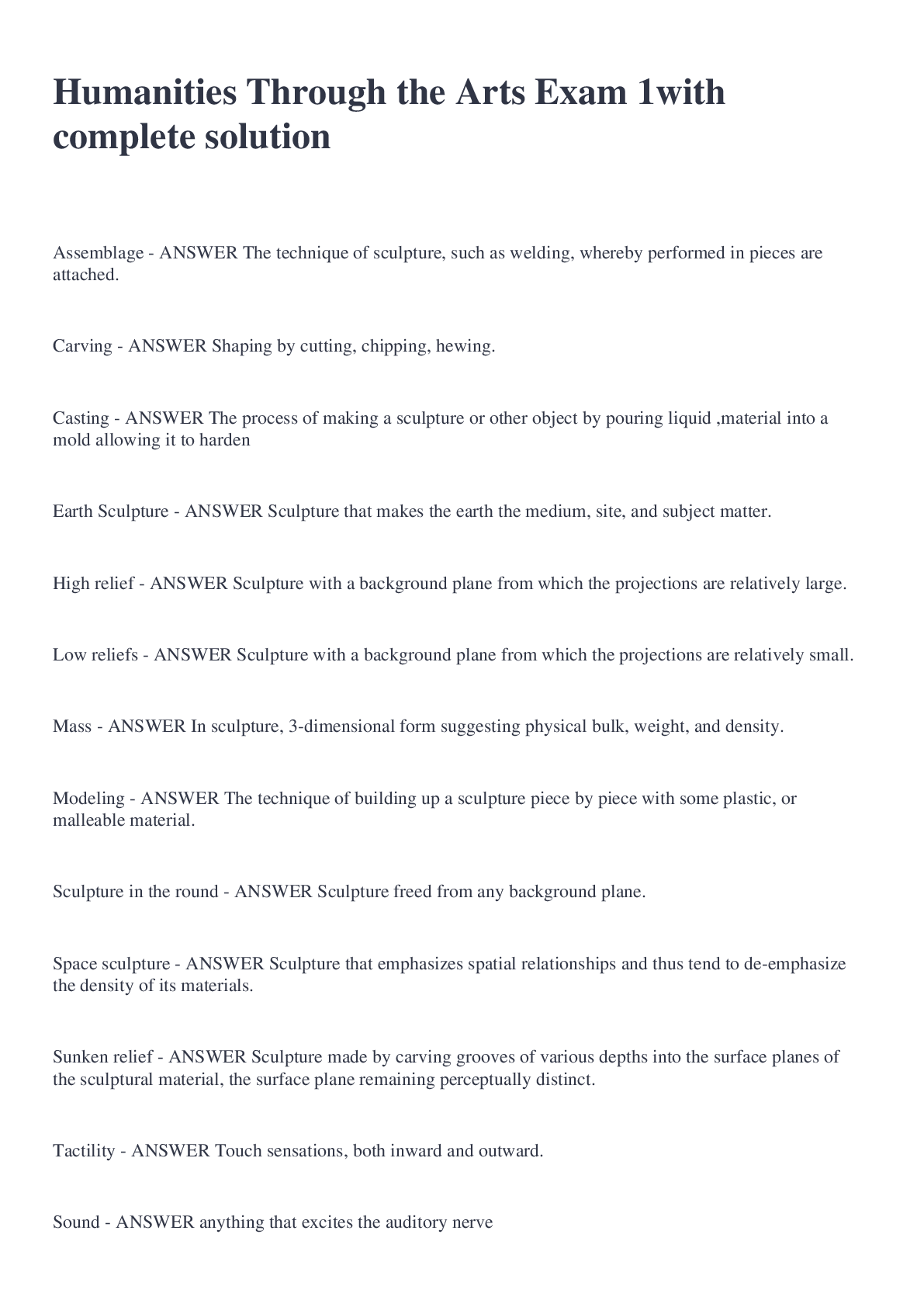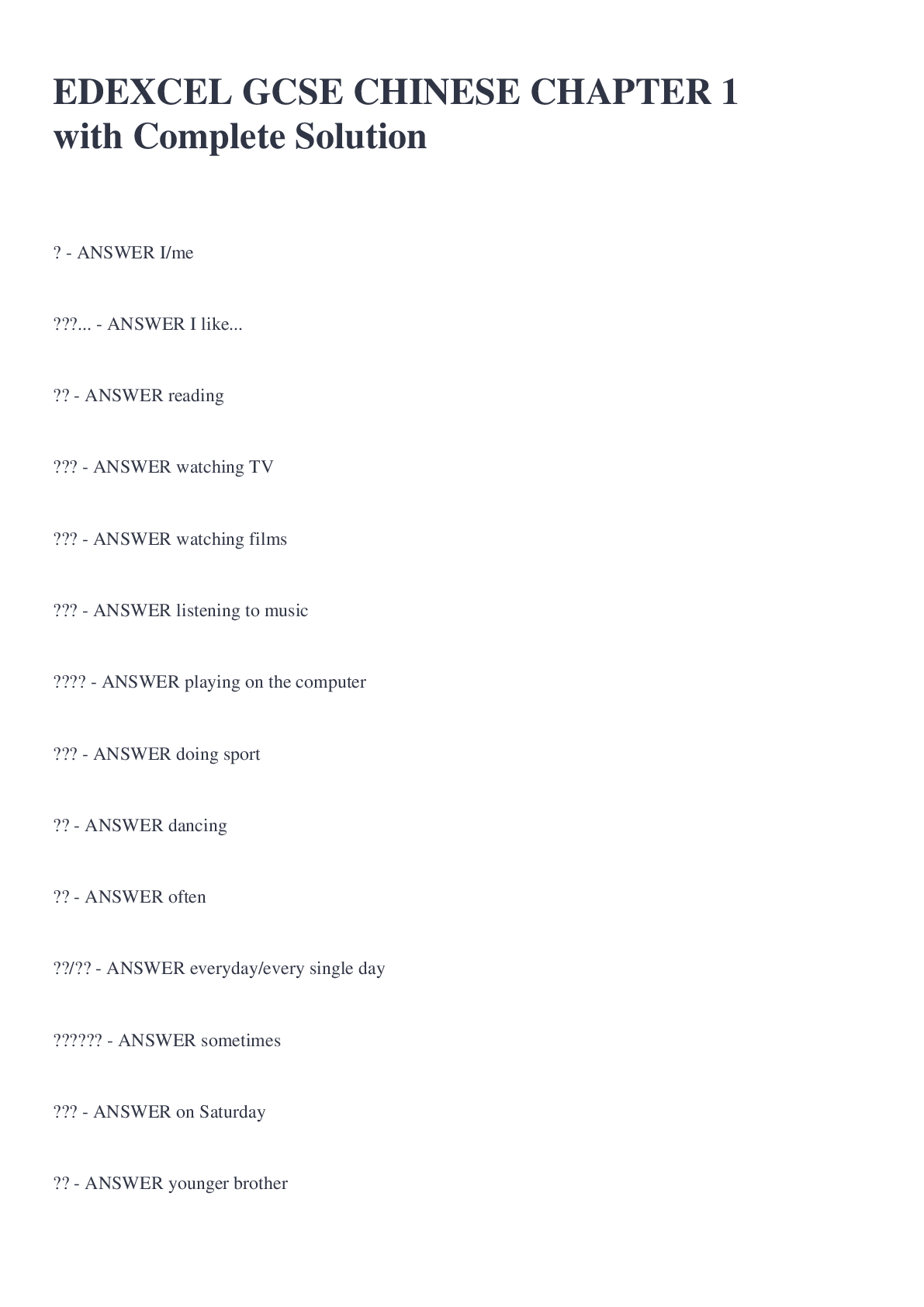Humanities Through the Arts Exam 1with complete solution
Document Content and Description Below
Assemblage - ANSWER The technique of sculpture, such as welding, whereby performed in pieces are attached. Carving - ANSWER Shaping by cutting, chipping, hewing. Casting - ANSWER The process of ... making a sculpture or other object by pouring liquid ,material into a mold allowing it to harden Earth Sculpture - ANSWER Sculpture that makes the earth the medium, site, and subject matter. High relief - ANSWER Sculpture with a background plane from which the projections are relatively large. Low reliefs - ANSWER Sculpture with a background plane from which the projections are relatively small. Mass - ANSWER In sculpture, 3-dimensional form suggesting physical bulk, weight, and density. Modeling - ANSWER The technique of building up a sculpture piece by piece with some plastic, or malleable material. Sculpture in the round - ANSWER Sculpture freed from any background plane. Space sculpture - ANSWER Sculpture that emphasizes spatial relationships and thus tend to de-emphasize the density of its materials. Sunken relief - ANSWER Sculpture made by carving grooves of various depths into the surface planes of the sculptural material, the surface plane remaining perceptually distinct. Tactility - ANSWER Touch sensations, both inward and outward. Sound - ANSWER anything that excites the auditory nerve tone/pitch - ANSWER has a definite frequency. It is the quality of sound (its highness or lowness) which is determined by specific number of vibrations per second (ABCDEFG) scale - ANSWER an arrangement of pitches played in ascending or descending order interval - ANSWER distance between any 2 pitches (half and whole steps) duration - ANSWER length of time vibration continues w/o interruption melody - ANSWER group of notes played one after another, having a perceivable shape of having a perceivable beginning, middle and end. A succession of sounds w/ organization conjunct contour - ANSWER melodies that hover around only a few notes using step wise motion disjunct contour - ANSWER melodies that jump around the pitch spectrum syllabic - ANSWER melodies that have on not per syllable of text Melismatic - ANSWER Each syllable of a word has many pitches assigned to it theme - ANSWER a melody that undergoes significant modifications in later passages motif/motive - ANSWER the briefest, intelligible and self-contained fragment or unit of a theme. A short melodic or rhythmic idea major - ANSWER melodies that sound happy minor - ANSWER melodies that sound sad harmony - ANSWER the sounding of tones simultaneously chord - ANSWER a group of notes surrounded together that has a specific relationship to a given key consonance - ANSWER when 2 or more tones are surrounded simultaneously and the result is pleasing to the ear. Harmonies that sound pleasant and stable dissonance - ANSWER tones sounding together that tend to be rough and unpleasant which is a result of wave interference and a phenomenon called "beating" cadence - ANSWER progressions to resting points that release tensions tonality - ANSWER the term applied to music that is composed in the major-minor key system harmonic rhythm - ANSWER rate of chord change rhythm - ANSWER the temporal relationship of sounds. Recurring pulses and accents that create identifiable patterns beat/pulse - ANSWER individual units we hear and which may be grouped into rhythmic patterns by placing accents meter - ANSWER the regular succession of rhythmical impulses or beats tempo - ANSWER the rate of speed rubato - ANSWER beat slows down presto - ANSWER rapid tempo allegro - ANSWER quick and lively tempo anadate - ANSWER moderately slow tempo lento - ANSWER slow tempo largo - ANSWER very slow tempo dynamics - ANSWER degrees of loudness or softness forte - ANSWER part of a song is meant to be played strongly and louder crescendo - ANSWER a gradual increase in loudness in a piece of music decrescendo - ANSWER gradually reducing force or loudness texture - ANSWER the melodic and harmonic characteristics of a composition monophony - ANSWER single musical line exists w/o accompaniment homophony - ANSWER chords accompany one main melody polyphony - ANSWER 2 or more melodic lines of relatively equal interest perform at the same time heterophony - ANSWER one melody is a decorated version of another density - ANSWER number of instruments or melodic lines present in a musical example low density - ANSWER a thin texture w/ few instruments [Show More]
Last updated: 2 years ago
Preview 1 out of 13 pages

Buy this document to get the full access instantly
Instant Download Access after purchase
Buy NowInstant download
We Accept:

Reviews( 0 )
$5.00
Can't find what you want? Try our AI powered Search
Document information
Connected school, study & course
About the document
Uploaded On
Oct 04, 2022
Number of pages
13
Written in
Additional information
This document has been written for:
Uploaded
Oct 04, 2022
Downloads
0
Views
59


















